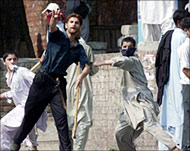Cleric murder highlights sectarianism
The deadly ambush that killed a top Pakistani cleric in Islamabad on Monday symbolises the end of a whole generation of zealous Sunni leaders.

Following his funeral, Maulana Azam Tariq’s enraged followers set ablaze a Shia mosque before police used tear gas and batons to chase them away.
However, the frenzy in Islamabad has only reinforced deep sectarian hatreds, particularly among those deeply coloured by radical versions of Islam.
Azam Tariq, a firebrand speaker, was the co-founder of the Sipah-e-Sahaba Pakistan (SSP), along with Haq Nawaz Jhangvi, Isar al-Haq Qasmi and Ziurrehman Faruqi.
The SSP was created in 1985 with the avowed mission of enforcing Islamic laws in Pakistan.
Assassinations
Tariq’s senior colleagues all lost their lives to either sniper shootings or bomb explosions, allegedly ordered by their Shia rivals spearheaded by Sipah-e-Muhammad (SM).
Born in 1962, Tariq obtained Masters degrees in Arabic and Islamiyat from a Karachi seminary before joining the Karachi wing of SSP in 1987.
He also ran an SSP seminary in Jhang before his elevation to the top party slot in 1997 after Faruqi’s assassination.
Tariq was sent to jail after President Pervez Musharraf announced a crackdown against “terrorist outfits” in January 2002.
|
“Religion actually became contentious in Pakistan only after Soviet-Russian occupation of Afghanistan in 1979″
Dr Anis Ahmed, |
But he was released after winning election to the Lower House in October about ten months later.
Massacre
Following the ban on militant outfits, including SSP, SM, Lashkare Jhangvi (the militant wing of SSP), Maulana Tariq had to rename his party Millat-e-Islamia Pakistan (MIP) to contest the general elections.
The MIP chief’s assassination comes after a string of sectarian violence incidents, which peaked in July at a Shia mosque in Quetta with the massacre of more than 50 people.
On 3 October, another six Shia Muslims were gunned down while on their way to the mosque for Friday prayers. At least three gunmen on a motorcycle opened fire on the bus transporting them.
Relatives and officials blamed the Karachi killings on Lashkar-e-Jhangvi, locked in running feuds with Shia counterpart Sipah-e-Muhammad. They had vowed revenge on the masterminds of the Karachi killings.
Sipah-e-Sahaba Pakistan has also been accused of involvement in a wave of violence between Pakistan’s dominant Sunni Muslims and the smaller Shia community, who account for about 15% of the population of 149 million.
Sectarianism
Iranian counsulates in Lahore and Multan and dozens of Shia and Sunni mosques have also been among targets of the sectarian attackers.
A senior official with the country’s civilian Intelligence Bureau believes the Sipah-e-Muhammad was the Iranian reaction to SSP, which allegedly drew its strength from Saudi Arabia.
“Religion actually became contentious in Pakistan only after Soviet-Russian occupation of Afghanistan in 1979,” said Dr Anis Ahmed, a scholar of Islamic history, jurisprudence and politics.
 |
|
Supporters of Azam Tariq rioted |
Observers also recount other factors that fanned sectarianism, such as the race among Muslim countries for credit in the anti-Soviet Jihad in the early 80s.
Pakistan’s military ruler General Zia al-Haq at that time was looking for allies to blunt a virulent opposition, particularly the Pakistan Peoples Party (PPP) of Benazir Bhutto.
Indian agents
The SSP turned out to be an effective shield not only against the PPP but also against some of the key anti-PPP political stalwarts like Sayyada Abide Hussein and her husband Sayyad Fakhar Imam.
By the mid 1990s, sectarian militants had taken the country by storm. Towns like Jhang, Faisalabad and Karachi became their virtual headquarters.
The lethal combination of “radical Islamism” and tolerance, if not support, by the country’s military intelligence outfits turned the SSP into a scarecrow for other political forces.
Religious outfits, particularly those like SSP suited Pakistan’s military establishment, which used them to browbeat and prevent civilian governments from taking decisions they did not approve of.
Nevertheless, given the current hostility with India, Pakistani officials are also quick to blame Indian agents.
They suggest it is the “foreign hand” that undertakes massacres to fuel religious hatreds.